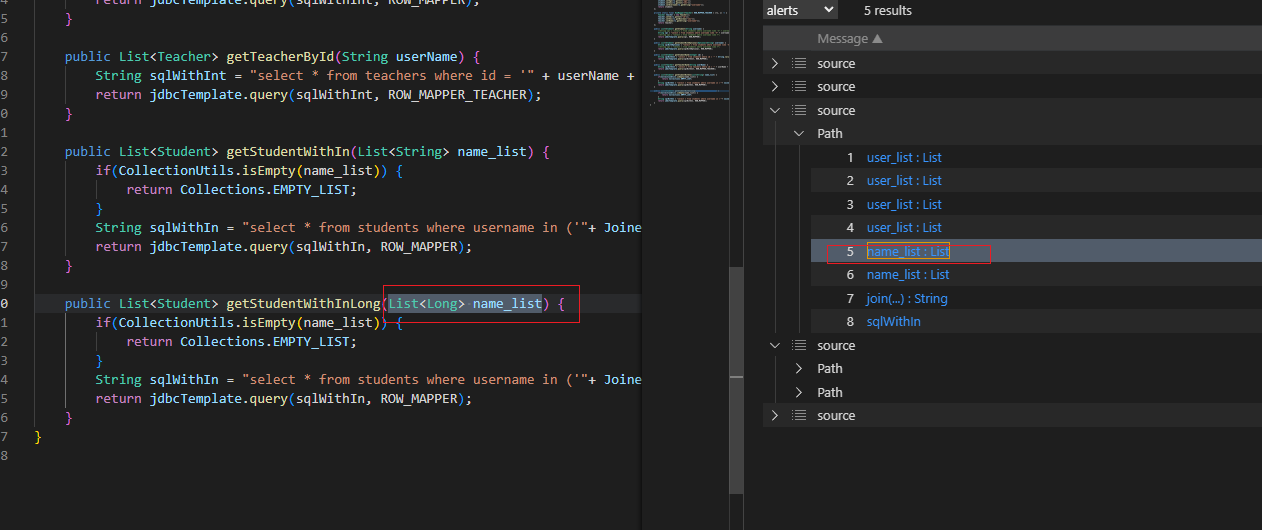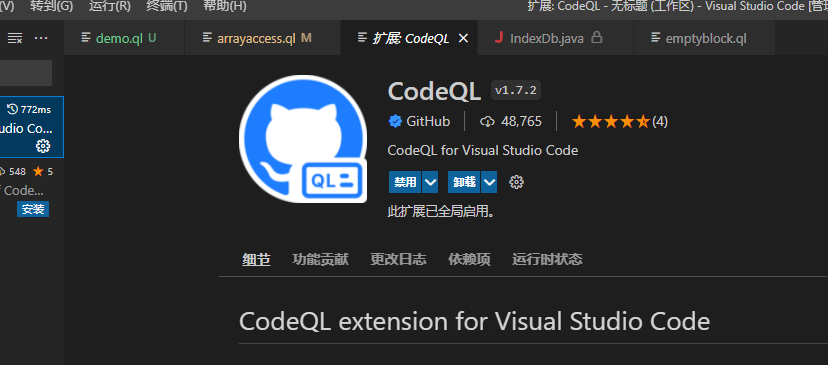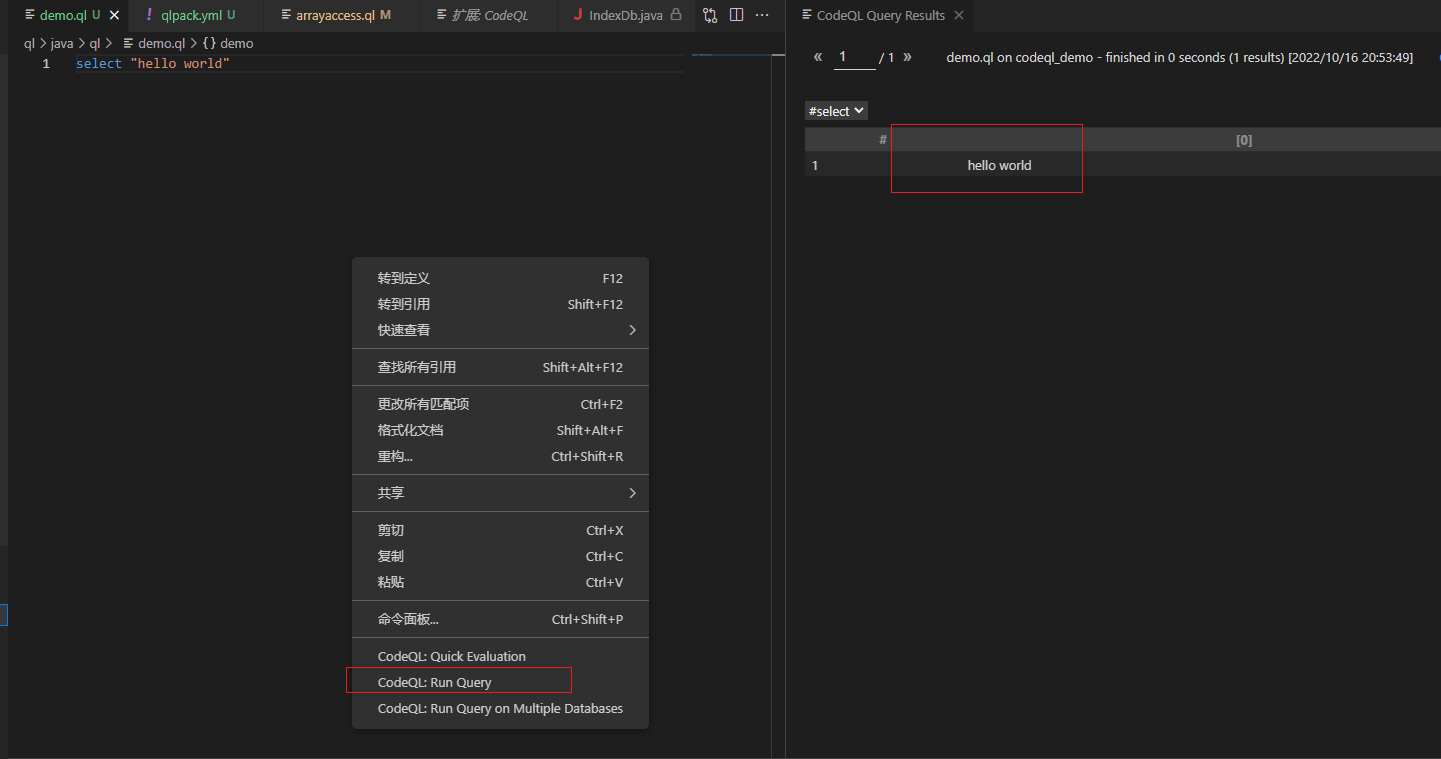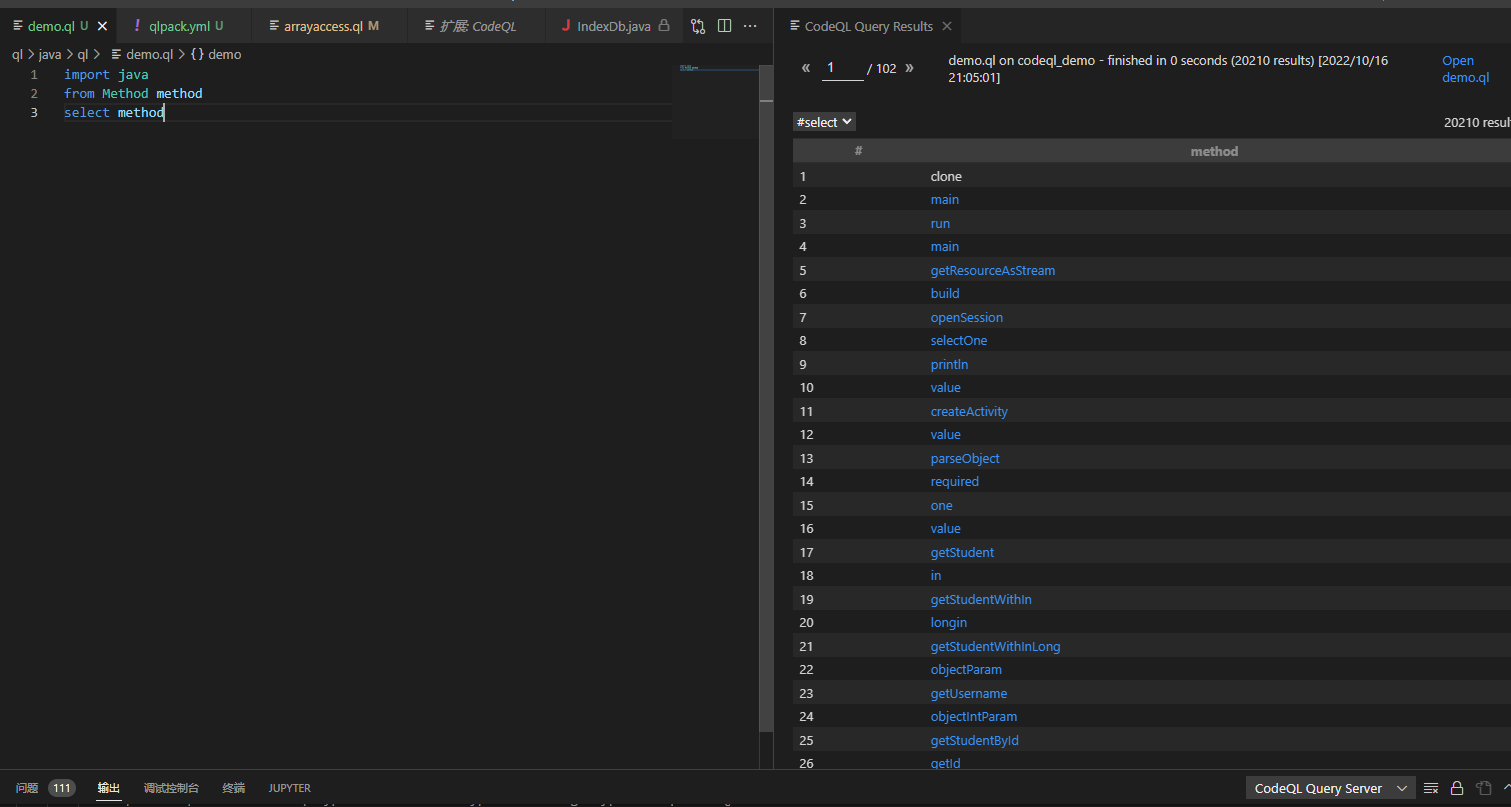Learn Codeql With L4yn3

小弟bingbingzi求着我学习Codeql,那就浅学一下,给小弟点面子。
Codeql安装
引擎安装
去https://github.com/github/codeql-cli-binaries/releases 下载对应系统版本的codeql引擎,并且添加到环境变量当中,在cmd中输入codeql可以查看是否设置成功
SDK安装
git clone https://github.com/Semmle/ql
VSCode插件

并且在设置当中设置好codeql可执行文件的路径即可
Codeql使用
使用l4yn3 师傅的靶场 https://github.com/l4yn3/micro_service_seclab/
为了测试刚刚的环境是否可用,用这个靶场来进行测试,命令如下
codeql database create ~/CodeQL/databases/micro-service-seclab-database --language="java" --command="mvn clean install --file pom.xml" --source-root=~/CodeQL/micro-service-seclab/
这里使用maven编译的时候会导致不成功,可以在pom.xml文件中加入如下代码
<plugin>
<groupId>org.apache.maven.plugins</groupId>
<artifactId>maven-surefire-plugin</artifactId>
<version>2.22.2</version>
<configuration>
<skipTests>true</skipTests>
</configuration>
</plugin>
先来看看上面的命令的意思,codeql database create就是创建一个数据库,--language就是语言为java,--command就是用这个命令去编译(python和php脚本不需要),--source-root就是项目路径
输入命令以后成功即可在vscode中导入数据库,也就是create后面的那个目录

然后使用vscode打开我们下载的sdk目录,在java/ql目录下可以新建个test.ql,输入select "hello world"即可测试,部分因为版本原因会报错,这时候需要先在 ql 文件同级目录下创建一个名为 qlpack.yml,内容如下:
name: mssql
version: 0.0.1
libraryPathDependencies: codeql/java-all
然后右键Codeql:run Query即可运行ql文件

Codeql语法
QL查询的语法结构为
from [datatype] var
where condition(var = something)
select var
经常会用到的ql类库如下:
| 名称 | 解释 |
|---|---|
| Method | 方法类,Method method表示获取当前项目中所有的方法 |
| MethodAccess | 方法调用类,MethodAccess call表示获取当前项目当中的所有方法调用 |
| Parameter | 参数类,Parameter表示获取当前项目当中所有的参数 |
Method
获取项目中定义的所有方法:
import java
from Method method
select method

获取名为getStudent的方法名称
import java
from Method method
where method.hasName("getStudent")
select method.getName(),method.getDeclaringType()

method.getName() 获取的是当前方法的名称
method.getDeclaringType() 获取的是当前方法所属class的名称。
谓词
类似于函数,其实就和函数差不多。对于上面的案例,可以修改一下
import java
predicate isStudent(Method method){
exists(|method.hasName("getStudent"))
}
from Method method
where isStudent(method)
select method.getName(),method.getDeclaringType()
predicate表示当前方法没有返回值,exists子查询,根据内部子查询返回true或者false,来筛选出数据
Source和Sink
什么是source和sink
在代码自动化安全审计的理论当中,有一个最核心的三元组概念,就是(source,sink和sanitizer)。
source是指漏洞污染链条的输入点。比如获取http请求的参数部分,就是非常明显的Source。
sink是指漏洞污染链条的执行点,比如SQL注入漏洞,最终执行SQL语句的函数就是sink(这个函数可能叫query或者exeSql,或者其它)。
sanitizer又叫净化函数,是指在整个的漏洞链条当中,如果存在一个方法阻断了整个传递链,那么这个方法就叫sanitizer。
只有当source和sink同时存在,并且从source到sink的链路是通的,才表示当前漏洞是存在的。
source通俗的说就是我们可控的变量,Sinkd通俗的说就是危险函数,这也就是代码审计的最基本的可控变量+危险函数。
设置Source
codeql中通过下面的代码来设置source
override predicate isSource(DataFlow::Node src) {}
可以看看我们靶场系统中的source是什么,比如
@RequestMapping(value = "/one")
public List<Student> one(@RequestParam(value = "username") String username) {
return indexLogic.getStudent(username);
}
采用了springboot框架,懂的师傅都知道,我们需要对/one路由传入username参数,在这,username就是source
@PostMapping(value = "/object")
public List<Student> objectParam(@RequestBody Student user) {
return indexLogic.getStudent(user.getUsername());
}
在这source就是user,和类型无关,本例中我们设置Source的代码为:
override predicate isSource(DataFlow::Node src) { src instanceof RemoteFlowSource }
这是SDK自带的规则,里面包含了大多常用的Source入口。我们使用的SpringBoot也包含在其中, 我们可以直接使用。
设置Sink
在本案例中,我们的sink应该为query方法(Method)的调用(MethodAccess),所以我们设置Sink为:
override predicate isSink(DataFlow::Node sink) {
exists(Method method, MethodAccess call |
method.hasName("query")
and
call.getMethod() = method and
sink.asExpr() = call.getArgument(0)
)
}
上面查询的意思为:查找一个query()方法的调用点,并把它的第一个参数设置为sink。
在靶场系统(micro-service-seclab)中,sink就是:
jdbcTemplate.query(sql, ROW_MAPPER);
Flow数据流
设置好 Source 和 Sink,就相当于搞定了首尾,但是首尾是否能够连通才能决定是否存在漏洞!
一个受污染的变量,能够毫无阻拦的流转到危险函数,就表示存在漏洞!
我们通过使用config.hasFlowPath(source, sink)方法来判断是否连通。
from VulConfig config, DataFlow::PathNode source, DataFlow::PathNode sink
where config.hasFlowPath(source, sink)
select source.getNode(), source, sink, "source"
初步成果
我们使用官方提供的TaintTracking::Configuration方法定义source和sink,至于中间是否是通的,这个后面使用CodeQL提供的config.hasFlowPath(source, sink)来帮我们处理。
我们最终第一版写的demo.ql如下:
/**
* @id java/examples/vuldemo
* @name Sql-Injection
* @description Sql-Injection
* @kind path-problem
* @problem.severity warning
*/
import java
import semmle.code.java.dataflow.FlowSources
import semmle.code.java.security.QueryInjection
import DataFlow::PathGraph
class VulConfig extends TaintTracking::Configuration {
VulConfig() { this = "SqlInjectionConfig" }
override predicate isSource(DataFlow::Node src) { src instanceof RemoteFlowSource }
override predicate isSink(DataFlow::Node sink) {
exists(Method method, MethodAccess call |
method.hasName("query")
and
call.getMethod() = method and
sink.asExpr() = call.getArgument(0)
)
}
}
from VulConfig config, DataFlow::PathNode source, DataFlow::PathNode sink
where config.hasFlowPath(source, sink)
select source.getNode(), source, sink, "source"
CodeQL语法和Java类似,extends代表集成父类TaintTracking::Configuration。
这个类是官方提供用来做数据流分析的通用类,提供很多数据流分析相关的方法,比如isSource(定义source),isSink(定义sink)
src instanceof RemoteFlowSource 表示src 必须是 RemoteFlowSource类型。在RemoteFlowSource里,官方提供很非常全的source定义,我们本次用到的Springboot的Source就已经涵盖了。
误报解决
在上面的初版代码中,会存在误报,这里的List泛型是Long,不可能注入的

这说明我们的规则里,对于List
isSanitizer是CodeQL的类
TaintTracking::Configuration提供的净化方法。它的函数原型是:override predicate isSanitizer(DataFlow::Node node) {}
在CodeQL自带的默认规则里,对当前节点是否为基础类型做了判断。
override predicate isSanitizer(DataFlow::Node node) {
node.getType() instanceof PrimitiveType or
node.getType() instanceof BoxedType or
node.getType() instanceof NumberType
}表示如果当前节点是上面提到的基础类型,那么此污染链将被净化阻断,漏洞将不存在。
所以我们只要在基本的内容上加点特殊的处理即可。
override predicate isSanitizer(DataFlow::Node node) {
node.getType() instanceof PrimitiveType or
node.getType() instanceof BoxedType or
node.getType() instanceof NumberType or
exists(ParameterizedType pt| node.getType() = pt and pt.getTypeArgument(0) instanceof NumberType )
}
如果当前node节点的类型为基础类型,数字类型和泛型数字类型(比如List)时,就切断数据流,认为数据流断掉了,不会继续往下检测。
漏报解决
有如下代码
public List<Student> getStudentWithOptional(Optional<String> username) {
String sqlWithOptional = "select * from students where username like '%" + username.get() + "%'";
//String sql = "select * from students where username like ?";
return jdbcTemplate.query(sqlWithOptional, ROW_MAPPER);
}
其中是通过username.get()获取的,应该是这里让他source-sink的链接断了,我们强制接上即可

isAdditionalTaintStep方法是CodeQL的类
TaintTracking::Configuration提供的的方法,它的原型是:override predicate isAdditionalTaintStep(DataFlow::Node node1, DataFlow::Node node2) {}
它的作用是将一个可控节点
A强制传递给另外一个节点B,那么节点B也就成了可控节点。
/**
* @id java/examples/vuldemo
* @name Sql-Injection
* @description Sql-Injection
* @kind path-problem
* @problem.severity warning
*/
import java
import semmle.code.java.dataflow.FlowSources
import semmle.code.java.security.QueryInjection
import DataFlow::PathGraph
predicate isTaintedString(Expr expSrc, Expr expDest) {
exists(Method method, MethodAccess call, MethodAccess call1 | expSrc = call1.getArgument(0) and expDest=call and call.getMethod() = method and method.hasName("get") and method.getDeclaringType().toString() = "Optional<String>" and call1.getArgument(0).getType().toString() = "Optional<String>" )
}
class VulConfig extends TaintTracking::Configuration {
VulConfig() { this = "SqlInjectionConfig" }
override predicate isSource(DataFlow::Node src) { src instanceof RemoteFlowSource }
override predicate isSanitizer(DataFlow::Node node) {
node.getType() instanceof PrimitiveType or
node.getType() instanceof BoxedType or
node.getType() instanceof NumberType or
exists(ParameterizedType pt| node.getType() = pt and pt.getTypeArgument(0) instanceof NumberType )
}
override predicate isSink(DataFlow::Node sink) {
exists(Method method, MethodAccess call |
method.hasName("query")
and
call.getMethod() = method and
sink.asExpr() = call.getArgument(0)
)
}
override predicate isAdditionalTaintStep(DataFlow::Node node1, DataFlow::Node node2) {
isTaintedString(node1.asExpr(), node2.asExpr())
}
}
from VulConfig config, DataFlow::PathNode source, DataFlow::PathNode sink
where config.hasFlowPath(source, sink)
select source.getNode(), source, sink, "source"
instanceof
instanceof是用来优化代码结构非常好的语法糖。
我们都知道,我们可以使用exists(|)这种子查询的方式定义source和sink,但是如果source/sink特别复杂(比如我们为了规则通用,可能要适配springboot, Thrift RPC,Servlet等source),如果我们把这些都在一个子查询内完成,比如 condition 1 or conditon 2 or condition 3, 这样一直下去,我们可能后面都看不懂了,更别说可维护性了。
况且有些情况如果一个子查询无法完成,那么就更没法写了。
instanceof给我们提供了一种机制,我们只需要定义一个abstract class,比如这个案例当中的:
/** A data flow source of remote user input. */
abstract class RemoteFlowSource extends DataFlow::Node {
/** Gets a string that describes the type of this remote flow source. */
abstract string getSourceType();
}
然后在isSource方法里进行instanceof,判断src是 RemoteFlowSource类型就可以了。
override predicate isSource(DataFlow::Node src) {
src instanceof RemoteFlowSource
}
Lombok问题
Lombok会自动生成get和set方法,正常代码就是
package com.l4yn3.microserviceseclab.data;
import lombok.Data;
@Data
public class Student {
private int id;
private String username;
private int sex;
private int age;
}
但是由于lombok的实现机制,导致CodeQL无法获取到lombok自动生成的代码,所以就导致使用了lombok的代码即使存在漏洞,也无法被识别的问题。
还好CodeQL官方的issue里面,有人给出了这个问题的解决办法([查看](https://github.com/github/codeql/issues/4984#:~:text=Unfortunately Lombok does not work with the CodeQL,the source files before running CodeQL as follows%3A))。
# get a copy of lombok.jar
wget https://projectlombok.org/downloads/lombok.jar -O "lombok.jar"
# run "delombok" on the source files and write the generated files to a folder named "delombok"
java -jar "lombok.jar" delombok -n --onlyChanged . -d "delombok"
# remove "generated by" comments
find "delombok" -name '*.java' -exec sed '/Generated by delombok/d' -i '{}' ';'
# remove any left-over import statements
find "delombok" -name '*.java' -exec sed '/import lombok/d' -i '{}' ';'
# copy delombok'd files over the original ones
cp -r "delombok/." "./"
# remove the "delombok" folder
rm -rf "delombok"
上面的代码,实现的功能是:去掉代码里的lombok注解,并还原setter和getter方法的java代码,从而使CodeQL的Flow流能够顺利走下去,从而检索到安全漏洞。
参考
https://www.freebuf.com/articles/web/283795.html